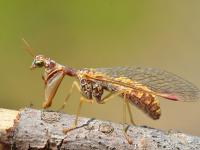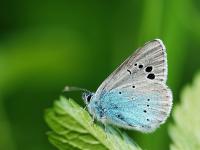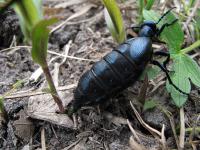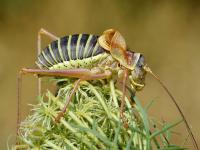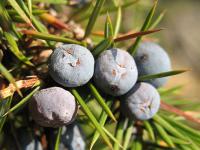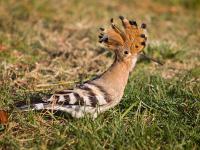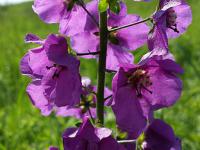|
Jersey tiger |
In Czechia, Jersey tiger is abundant in places that are suitable for its life - light forests and forest edges in dry and warm areas. It is a moth, i.e. it flies at night, but we can often see it during the day as well. It feeds on and develops in a variety of plant species; it is not a speciality like many other butterflies. According to the Habitats Directive, it is a priority species which deserves special protection in Europe. |
|
elder-flowered orchid |
Elder-flowered orchid occurs on meadows, pastures and shrubby hillsides. It has two colourful forms - yellow and red; exceptionally, a transitional pink version also appears. Both can appear on one site, while the yellow one is more common and usually flowers earlier then the red one. In Czechia, it is a highly endangered species protected by law. It is threatened mainly by overgrowth of meadows. |
|
dwarf everlast |
Dwarf everlast is a small shrub growing on sandy soils. It is used in traditional medicine, primarily to deal with problems of the digestive system, including the gallbladder and liver. We can see it in gardens; however, wild dwarf everlast is a highly endangered species and it is protected by law. |
|
greater pasque flower |
Greater pasque flower is a symbol of spring in warm areas of Moravia, although exceptionally it can flower in autumn as well. It blooms so early that it does not even manage to grow its leaves - they only appear after flowering. By that time, the flower changes into a hairy ball, also well recognizable. It grows in sunny habitats. In our country, it is highly endangered and protected by law. |
|
Lulworth skipper |
Lulworth skipper is a critically endangered butterfly that occurs on steppe sites which must be overgrown by certain number of shrubs. Therefore, the maintenance of the sites of its occurrence is very difficult. Its caterpillars only feed on a grass called heath false brome. When the caterpillar hatches from the egg in late summer, it immediately spins the cocoon in which it hibernates. It only starts eating in spring. |
|
green-underside blue |
Green-underside blue occurs on steppe and forest-steppe sites, or also on railway embankments or not very utilized pastures. It needs the right amount of shrubs - not too few, not too many. In Czechia, it currently occurs only on three sites, two of which are military areas; it is more abundant in South Moravia. |
|
bloodword burnet |
Bloodword burnet is our rarest burnet; it is listed in the endangered category on the Red List of endangered species. We can see the flying adult individuals during the summer holidays. They lay eggs on a plant called field eryngo. |
|
hairy feather grass |
Feather grasses are grasses growing on steppes and are easily recognizable by their inflorescences which look like bird feathers. In our country, hairy feather grass is the most common species of this group. Its leaves are hairy as well. It creates dense clumps on hillsides in warm areas. |
|
Astragalus austriacus |
The milk-vetch species Astragalus austriacus is a legume, therefore it is relative to peas and lentils. It grows on dry sunny hillsides. It is a flower that is half erect and half lying on the ground - its stems are spread out over the ground and only parts of them point upwards. These are the parts that bloom. It is protected by law as highly endangered. |
|
green-winged orchid |
Green-winged orchid has a peculiar name in Czech as well as Latin. The translation of its Latin name is 'jester', because its flower resembles a jester's hat. In the past, it was one of our most common orchids, nowadays it is more common only in Pošumavà (ethnographic region at the foothills of Šumava mountains), foothills of the Carpathians, and Upper Podyjà (Thayatal). It is listed as critically endangered on the Red List, and according to the law it is protected as critically endangered. A drink called "salep" is made from the tubers of some orchid species, leading to the devastation of these plant populations. |
|
Styrian praying lacewing |
Styrian praying lacewing Similar to the praying mantis, Styrian praying lacewing has a trapping device made from the front limbs, by which it mainly catches flies. The northern border of its distribution crosses our country; it occurs only in South Moravia (in Bohemia, it was once found near Litom??ice). It is quite common in PodyjĂ National Park, it has probably died out in VátĂ© pĂsky NPP. It is protected as a critically endangered species. |
|
saddle-backed bush cricket |
The saddle-backed bush cricket is quite robust - it can measure up to 3 cm. Its antennae are roughly twice as long as the body. It lives on the bushes between which it runs because its wings are stunted. It prefers mainly individually growing trees and shrubs. It is predatory, hunting for smaller invertebrates. It is not protected, but is declining because there is less and less forest steppes where it could live. |
|
lack oil beetle |
The lack oil beetle lives in warm steppe areas. It measures up to 5 cm and cannot fly. All our oil beetles are protected by law. They were once used by poisoners because they secrete cantaridine, which is fatal in humans at 30 mg. |
|
barred warbler |
The barred warbler is a bit of a reduced-size cuckoo, at least in appearance. However, it builds its own nest and takes care of the young. It inhabits sunny hillsides with scattered bushes, but there must not be too many of them. It is protected by law as endangered. |
|
common heather |
Common heather gave its name to one of the landscape types -heathland, where it is dominant. It is a 20-50 cm tall bush, which also prospers in places with grazing cattle or frequent fires. Fire is a natural part of the heathland life cycle - the seeds germinate best in places that have gone through fire. |
|
Eurasian hoopoe |
Eurasian hoopoe is noticeable both with its punk mohawk and black and white wings and tail. It has a very distinctive voice from which its Latin name is derived (Upupa). In the past, we would often be able to see it hovering over pastures where it was looking for something to eat a caterpillar, an ant, sometimes a lizard. Unfortunately it is endangered today, mainly due to overgrowth and abandonment of the landscape. It lives in the hollows of old trees. |
|
red-backed shrike |
Although the red-backed shrike is smaller than the blackbird, it is a big predator, as its beak suggests. It is able to catch a big beetle, mouse or lizard. Males often boast of their catches, hanging them around a nest on thorny bushes to show females how good they are. It is protected as endangered, but fortunately its numbers are growing. |
|
tree grayling |
The tree grayling is a tiny butterfly bound to sands without trees and with non-stratified vegetation. It died out in Czechia  the last species site was Pánov training ground, where it was last recorded in 1995. The last straw was the overgrowth and afforestation of the sands by pine trees. However, it still occurs not far beyond the borders  in Slovak ZáhoĹ™Ă, which is an active military area.. |
|
woodlark |
A lot of people say a woodlark is a better singer than a nightingale. It even won a Czech Radio poll. It nests mainly in pine forests on sands, heaths and in old orchards. In our country, it is protected as a highly endangered species. |
|
grey hair-grass |
Grey hair-grass is a bit of a wild west pioneer - as one of the first grasses, it is starting to grow on hollow sands. It is among the species that is potentially endangered in our country, but so far it its populations are doing okay. |
|
common juniper |
Common juniper is used to make gin and Juniper brandy, as well as to flavour meat, especially venison. It grows in pine forests, on pastures and hillsides, and hates excessive shading. We often recognize old, unused pastures just because of the fact that there is juniper. Juniper berries are also bird food. Therefore, in the past, fieldfares were hunted mainly in the autumn, when they nicely "pickled" themselves. |
|
purple mullein |
Mulleins are usually yellow; however, there is one purple one occurring in Czechia - purple mullein. It grows on grassy and rocky spots in warm areas. It is an endangered species protected by law. |














